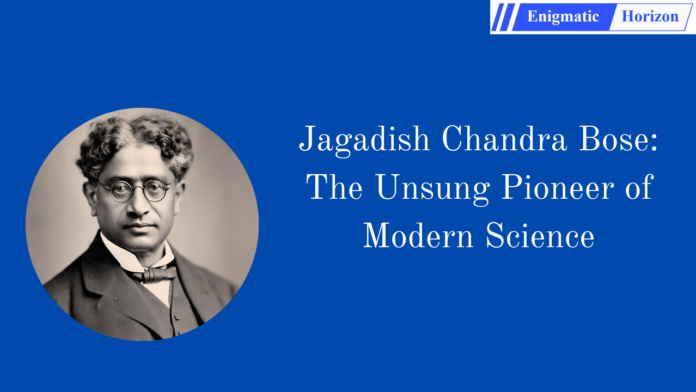Reetika Choudhury
In the chronicles of scientific history, when India was under British predominance, one luminary who stands out is Jagadish Chandra Bose. Born on 30th November, 1858, in Mymensingh, Bengal Presidency (present-day Bangladesh), Bose elevated the nation’s status through his experiments and discoveries. It is surprising that how his significant contributions have been obscured by the passage of time, even in modern textbooks.
In this article, we will delve into his life and achievements, discussing his contributions across various scientific fields and exploring why he is revered as the Father of Bengali Science Fiction.
Early Life and Education
Jagadish Chandra Bose, known as J.C. Bose, was born in a Bengali Kayastha family, to Bama Sundari Bose and Bhagawan Chandra Bose. Bose was sent to a Bengali-language school for his early education, as his father believed that Bose should study in his native language before studying in English. Later he joined the Hare School in Kolkata and graduated from St. Xavier’s College, Kolkata. Bose attended University of London to study medicine, but had to quite due to health complications. Later, he secured admission in Christ’s College, Cambridge to study natural sciences.
In 1883, he received BSc from the University College London as well as BA from the University of Cambridge in 1884.
Bose’s Significant Contribution to Science and the Challenges faced
Acharya Jagadish Chandra Bose was a polymath with a keen interest in biology, physics, botany, and was an early writer of science fiction. He was responsible for the expansion of experimental science in India. In 1885, he was appointed as an officiating professor of Physics at Presidency College, Kolkata, where he also began researching microwaves. Bose struggled in his early years as a professor, due to inadequate funding and workspace. Despite being paid less than British colleagues, he worked for free for three years until the university agreed to pay him equally and provide back pay and made his appointment permanent, with retrospective effect.

Contributions of JC Bose in Physics
In 1895, Bose showcased wireless transmission of electromagnetic waves through walls and even human bodies, predating Popov and Marconi’s experiments. Despite Marconi receiving the Nobel Prize, Bose’s pioneering work in radio and wireless communication went unrecognized.
Bose pioneered the use of ultra-high frequency microwaves up to 60 GHz in his experiments. He developed novel equipment like horn antennas and waveguides, laying the foundation for modern microwave engineering and astronomy. His focus was on the optical properties of microwaves rather than their signalling potential, marking groundbreaking work in the field. He also popularised numerous other instruments and called them “Bose instruments”.
Invention of the Mercury Coherer
He invented a new coherer made of a metal cup containing mercury, to detect the signal of his own invention in 1894. His work in this field laid the foundation for later advancements in radio and telecommunications. Bose’s coherer was actually a semiconductor diode, and his work in this field led to the world’s first patent on solid-state diode detectors, granted in US in 1904.
Contribution to Plant Physiology
J.C. Bose, known for his breakthroughs in plant physiology, later delved into electrophysiology, advancing understanding of biophysical phenomena.
He contrived a very sophisticated instrument called the crescograph, which could record and observe plants’ minute responses to external stimulants, which was capable of magnifying the motion of plant tissues to about 10,000 times their actual size and, in doing so, he found many similarities between plants and other living organisms.
His work challenged conventional scientific beliefs and led to the discovery of the similarities between plants and animals in responding to stimuli.
Advaita Vedanta and Plant Perception: Bose’s Pioneering work
Bose was a member of the Unitarian Brahmo fraternity, which included notable Bengalis such as Rabindranath Tagore and Raja Rammohan Roy. Brahmoism, rooted in the principles of Advaita Vedanta, the genesis of which can be captured in a verse from Rig Veda, which meant “Truth is one, the wise call it by various names”. This philosophy centers on the universal concept of unity. Bose’s quest for unity led him to discover similarities between plant and humans. He theorized that plants, like humans and animals, area alive, thus laying the groundwork for emerging fields like plant neurobiology and plant cognition.
Bose’s Hidden Contributions to Radio Technology and His Enduring Legacy
Bose established the Bose Institute, a leading research Institute in India and one of its oldest, founded in 1917. This institute was the first interdisciplinary research center in Asia. Bose served as its director from its inception until his death.
Jagadish Chandra Bose’s contributions to radio technology remained largely unrecognized for many years, only gaining acknowledgement in recent times. Francesco Marconi, the grandson of Guglielmo Marconi, highlighted Bose’s pioneering role in radio invention during one of his lectures, referring to his grandfather as the promoter of the technology. Additionally, the IEEE honoured Bose with the title “Father of Radio Science”.
